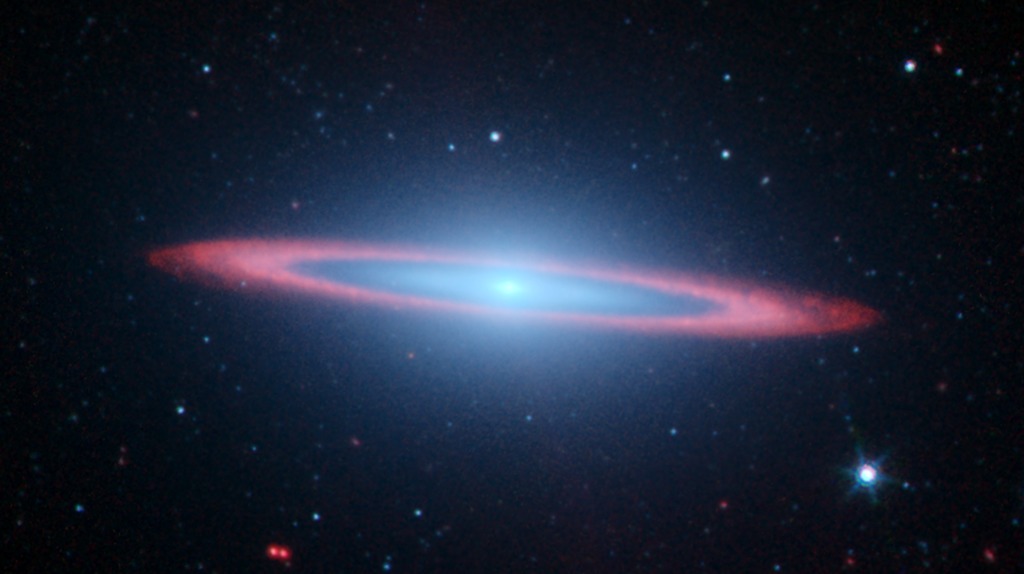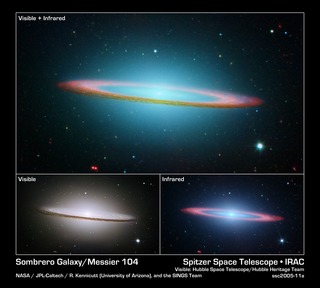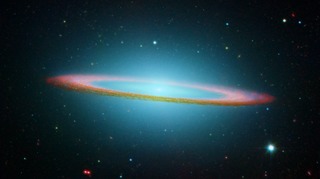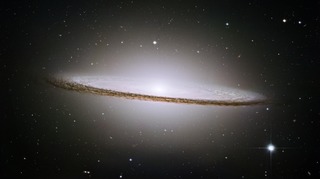
Credit: NASA/JPL-Caltech/R. Kennicutt (University of Arizona) and the SINGS Team
Observation • May 4th, 2005 • ssc2005-11a3
ssc2005-11a3
NASA's Spitzer Space Telescopes created this striking infrared image of one of the most popular sights in the universe. Messier 104 is commonly known as the Sombrero galaxy because in visible light, it resembles the broad-brimmed Mexican hat. However, in Spitzer's striking infrared view, the galaxy looks more like a "bull's eye."
In visible light images, only the near rim of dust can be clearly seen in silhouette. Recent observations using Spitzer's infrared array camera uncovered the bright, smooth ring of dust circling the galaxy, seen in red. Spitzer's infrared view of the starlight, piercing through the obscuring dust, is easily seen, along with the bulge of stars and an otherwise hidden disk of stars within the dust ring.
Spitzer's full view shows the disk is warped, which is often the result of a gravitational encounter with another galaxy, and clumpy areas spotted in the far edges of the ring indicate young star-forming regions.
The Sombrero galaxy is located some 28 million light-years away. Viewed from Earth, it is just six degrees south of its equatorial plane. Spitzer detected infrared emission not only from the ring, but from the center of the galaxy too, where there is a huge black hole, believed to be a billion times more massive than our Sun.
The Spitzer picture is composed of four images taken at 3.6 (blue), 4.5 (green), 5.8 (orange), and 8.0 (red) microns. The contribution from starlight (measured at 3.6 microns) has been subtracted from the 5.8 and 8-micron images to enhance the visibility of the dust features.
About the Object
- Name
- Sombrero Galaxy • Messier 104 • M104 • NGC 4594
- Type
- Galaxy > Type > Elliptical
- Galaxy > Type > Lenticular
- Galaxy > Component > Ring
- Galaxy > Type > Ring
- Distance
- 28,000,000 Light Years
- Redshift
- 0.003416
Color Mapping
| Band | Wavelength | Telescope |
| Infrared | 3.6 µm | Spitzer IRAC |
| Infrared | 4.5 µm | Spitzer IRAC |
| Infrared | 5.8 µm | Spitzer IRAC |
| Infrared | 8.0 µm | Spitzer IRAC |
Astrometrics
- Position (J2000)
- RA =12h 39m 45.9s
- Dec = -11° 35' 13.1"
- Field of View
- 9.6 x 5.4 arcminutes
- Orientation
- North is 5.1° right of vertical







